Publication
auri Research Brief
Baby Boomers' Perceptions of Ageing in Place (AIP) and Housing Demands: with a Focus on Seven Metropolitan Cities
- No.88
- 2024.04.29
- Hit 352
- Yun, Jinhee Associate Research Fellow
- Byun, Eunjoo Assistant Research Fellow
- Bang, Jaesung Associate Research Fellow
With various housing demands, a larger number of baby boomers are steadily joining the ageing population. As ageing in place (AIP) policies become more widespread, now is the time to explore ways
to satisfy the baby boomers' desire to settle. In particular, various senior housing service models need to be developed to provide community-based medical and care-related residential support to older adults so they can live independently in familiar living environments.
Baby Boomers Encounter the Ageing Population
While ageing is a global phenomenon due to increased life expectancy, ageing in South Korea has been noticeably faster compared to other countries. After becoming an “ageing society,” which refers to a society where the ageing population aged 65 or older accounts for 14% of the entire population, in 2017, Korea is set to become a “super-aged society” in eight years, i.e., 2025, when the
proportion of the ageing population exceeds 20 percent.
Born between 1955 and 1963, the baby boomers in particular have been steadily joining the ageing population in large numbers since 2020 and are soon expected to account for approximately 41% of this population segment. Having experienced industrialization, baby boomers are demographically and socially more educated and wealthier compared to the traditional ageing population, and
they recognize the need to prepare for their later years earlier without expecting to be supported by their children.
Ageing in place (AIP) strategies, which allow older adults to age in familiar places and extend the period of their independent lives, have become more widespread as alternatives to addressing the challenges of a super-aged society. In this context, this article explores strategies to support housing for older adults through a survey of the AIP perceptions and housing demands of baby boomers, who will account for a large portion of the ageing population.
Healthy Homeowners with a High School Diploma or Higher, Living in Multi-Family Housing
A survey was conducted to explore the baby boomers’ perceptions of AIP and their desire to settle. It involved 1,500 male and female baby boomers born between 1955 and 1963 and residing in seven metropolitan cities in South Korea, out of which 1,344 responses were collected.1)
97.5% of the baby boomer respondents had a high school diploma or higher, and 65.7% graduated from community colleges, universities, or higher institutions. Only 9.0% were not homeowners, which confirmed that nine out of ten respondents (91.0%) were homeowners. The average size of the respondents’ residences was 30.3 pyeong (about 100.16 square meters), and many of the respondents (76.9%) were living in their own homes. 13.4% lived alone, indicating that most respondents (86.6%) lived with their spouses or one or more family members.
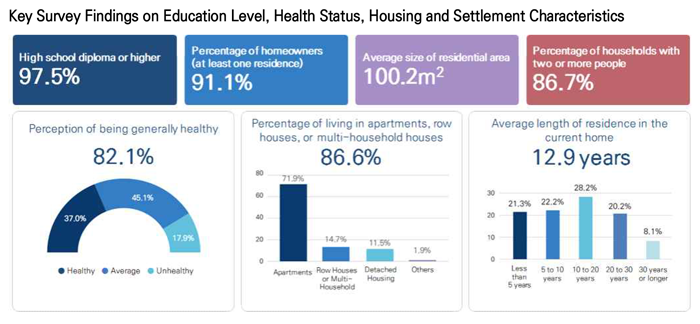
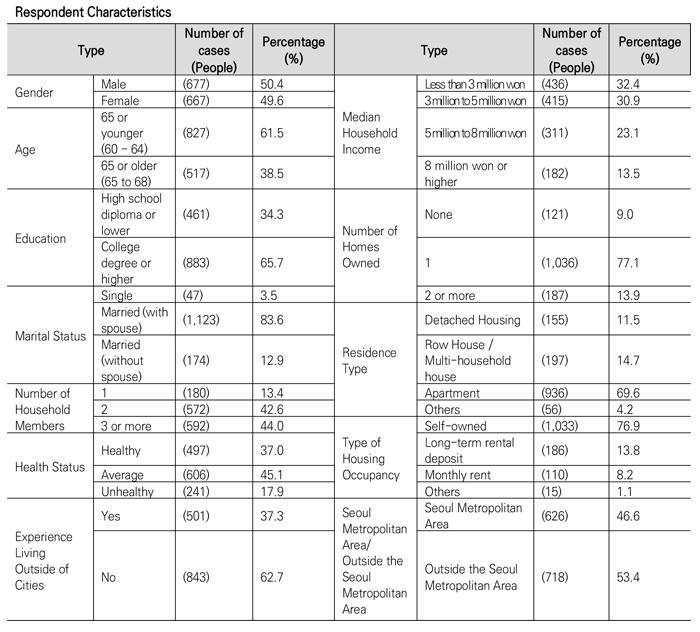
[Ageing: Perception of Ageing] Old Age Starts at Retirement, but “I’m Not Old Yet.”
Age standards for older adults vary. The age standard for older adults is set to 55 for reverse mortgage loans, and for the National Pension Service’s old age pension, the standard has been raised from 63 (for those born between 1961 and 1964) to 65 (for those born in 1969 or after) (Article 8, Addenda to Act No. 8541). The Welfare of Senior Citizens Act sets the age standard at 65. Given that this is
also related to one’s retirement age and economic and social activities, age standards for older adults are garnering more attention, along with the increased life expectancy and life cycle changes.
Not only the legal or social standards for old age but the point in time an older person perceives oneself to be old, as well as the age at which the state perceives a person to need care, affect the socio-economic participation and activities of older adults. Such standards are also closely linked to when the beneficiaries of policies for older adults consider it the proper timing to
undertake policy implementation.
When asked about “when old age begins,” baby boomers ranked “when you retire from work” (34.4%) and “when you begin receiving a public pension (such as a national or old age pension)” (29.5%) as their top two choices. This result indicates that the age standard prescribed by systems or policies has a significant impact on how an individual perceives when one’s old age begins. Other
responses included those that were subjective, such as ‘when your energy level drops’ (21.3%). On the other hand, many respondents concurred that one’s “60th birthday,” the traditional standard of old age, is no longer seen as the beginning of old age.
When asked whether they consider themselves older adults, 84.8% of the baby boomer respondents replied, “No,” whereas 90.8% of respondents 65 and younger replied that they do not consider themselves older adults. Among the respondents aged 65 and older who passed the age of retirement and public pension, 75.2% responded that they do not consider themselves older adults, a rate lower than those aged 65 and younger.
When asked about “the age you consider yourself as older adults,” the average response was 69.9 (median 70 years old). Respondents aged 65 and younger responded with 69.5 years old, while those aged 65 and older reported 70.7 years old, both of which were higher than 65, the conventional age standard for older adults. The mean age in response to a question concerning the “age when one can live independently without help from others” was 75.7 years old on average (median 75 years old), and the “age when state assistance and support becomes important” was 70.7 years old (median 70 years old).
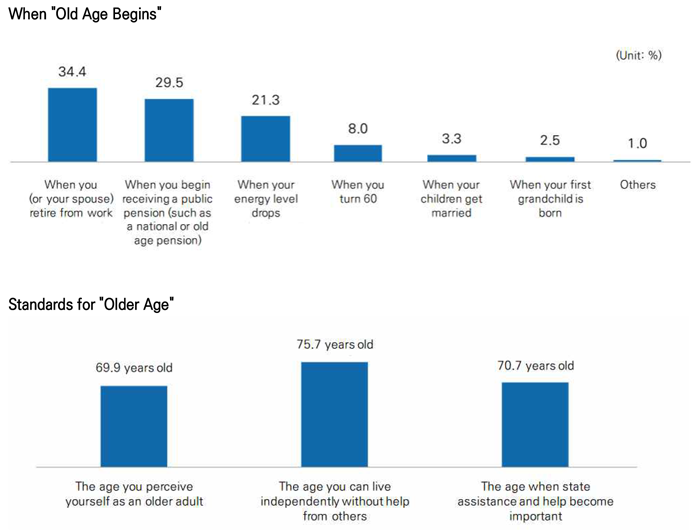
[In: Spatial Extent] I want to age in my home where I have lived for years or in a familiar neighborhood within a 20-minute walk.
When asked if they wish to continue to AIP, 65.5% of the respondents replied that they would like to age in “their current home or neighborhood.” 41.7% of the respondents replied they wanted to continue living in their current home or neighborhood even if their health worsens and they experience limited mobility. The older adults’ desire to settle in one’s community as found here is consistent
with the findings of several previous studies conducted in Korea and other countries. Nevertheless, opinions vary with regard to the spatial extent of AIP. In a narrow sense, it may indicate one’s own home, that is, one’s home, and in a broader sense, it can refer not only to one’s “places,” such as a frequently visited grocery store, but also to a “space” that encompasses time and relationships, including one’s familiar relationships and community.
Regarding the spatial extent of AIP, 56.8% of respondents replied that it was their “current home,” whereas 43.2% understood it to include their living space by reporting that it was their “current neighborhood.” When asked about the spatial extent of the “neighborhood” as the place for AIP, 95% of the respondents replied that they recognized an area within a 20-minute walk as their familiar local
community. Male respondents who were 65 or older displayed a greater tendency to want to age in their current homes. In contrast, female respondents who were 65 or older tended to report that they could not live outside their familiar neighborhood even if they had to move to a new home.
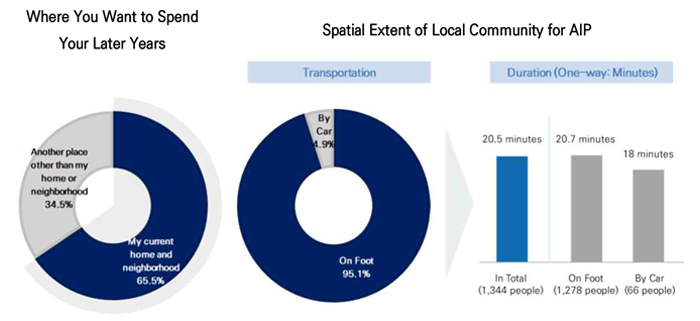
Many respondents conveyed that they wanted to continue ageing in their current homes and neighborhoods due to “family and friends” (24.5%) and “familiarity” (21.9%), but overall, the survey showed that “to live in the city center where public transportation and convenient facilities are easily accessible” (61.9%) and “to easily access medical and health-related facilities” (58.0%) were also critical factors among the respondents’ choices. Meanwhile, respondents who wanted to stay in the same neighborhood but wanted to move to a new home to AIP cited “My current home is old” (32.1%), “To change the house type” (23.9%), and “My current home needs more facilities and equipment to spend my later years” (13.4%) as reasons behind their choices. Reasons for wanting to leave their current neighborhood included “to live in a place with a good natural environment” (54.7%), “to live in a cheaper place” (14.7%), and “to live in a place with good and easily accessible medical and health-related facilities” (10.1%).
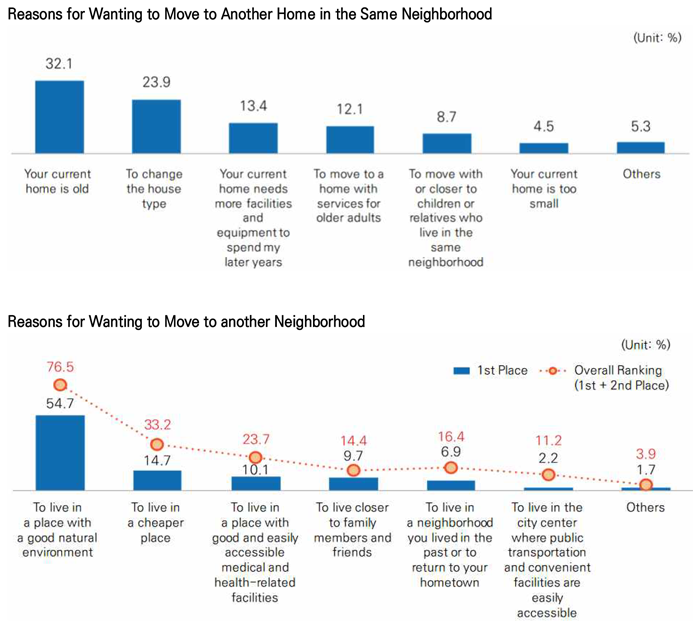
[Place: Residential Environment] Skeptical of House Remodeling…Medical Facilities and Parks Are Essential for Neighborhoods
Older adults want to continue living where they used to live owing to the sense of intimacy and stability they feel from familiar spaces, facilities, and relationships. The baby boomer respondents here expressed that they wanted to continue living in their current homes or neighborhoods despite limited mobility (41.7%). However, only 32.7% responded with a “Yes” as to whether they felt remodeling their homes for their later years would be necessary. One interpretation in this case is that home remodeling may not be perceived as a viable housing support measure for baby boomers who still feel that they are in good health. However, single women in their 60s living in single households with an income of less than 3 million won were more likely to acknowledge the need to remodel their homes.
The most important considerations for house remodeling for old age included “safety improvements to prevent accidents that may occur due to lower physical and cognitive functions caused by ageing or illness,” at 48.1%, followed by “home improvements to maintain optimal lighting, ventilation, and temperature” (29.0%) and “home automation improvements for convenience” (16.4%). In addition, more than six out of ten respondents (67.0%) replied that they were willing to remodel their current homes for their later years at their own expense, and the maximum payable amount was 16.86 million won on average.

The most popular house type to move into for one’s later years was “apartments” at 36.6%, followed by “silver towns or silver houses that provide healthcare services” (31.0%) and “detached housing” (23.6%). Respondents tended to favor familiar house types, considering that apartment residents preferred living in apartments, whereas detached housing residents preferred detached housing.
By age group, respondents in their 60s preferred to live in apartments, while those in their late 60s preferred living in silver towns or houses that provide healthcare services. This result differed from those of previous studies that argued that older adults had an aversion to healthcare services offered by silver towns or silver houses, and it can be interpreted that people in their late 60s are more likely to consider moving from their own homes into senior housing facilities with healthcare services. The demand for healthcare and medical support can be identified as one of the characteristics of baby boomers’ desire to settle, as “support for physical health” (39.8%) was selected as the most necessary resource for ageing in their current residence. Furthermore, “healthcare facilities” (49.1%) and “parks” (15%) ranked first and third as the most necessary facilities, indicating baby boomers value health-related facilities and spaces in their living environment for ageing.
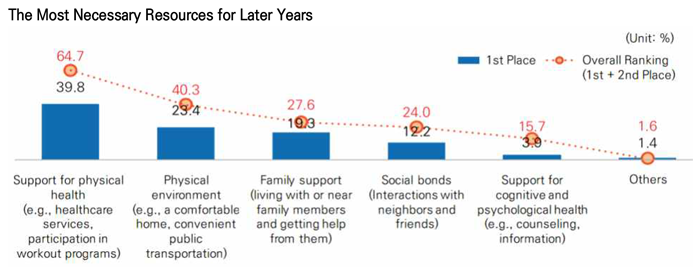
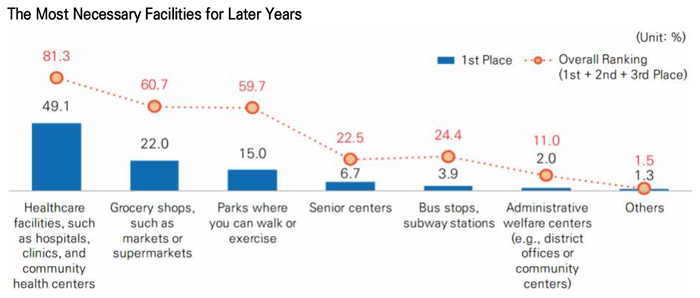
Support for Local Healthcare and Senior Care Services and Various Types of Serviced Housing Needed
According to the 2020 Housing Survey of Older Adults, 83.8% of all respondents aged 65 or older reported that they wanted to live in their current homes as long as they were healthy. Interviews from a case study of older adults aged 75 or older conducted by the Korea Institute for Health and Social Affairs in 2017 also showed how older adults were more likely to continue living in their current homes until death and were more opposed to moving to new regions or houses. Similar to the demands of older adults found in previous studies, this study also found that baby boomers living in the seven metropolitan cities prefer AIP. The difference was that the baby boomers selected “accessibility to medical and health-related facilities” and “support for healthcare and senior care services” as critical factors for AIP. There was also a demand for moving to senior housing facilities, such as silver towns and senior service houses.
Traditional older adults have displayed a tendency to live in their homes until they have limited mobility and then to move to senior facilities, from which they will involuntarily move to long-term care hospitals. This was affected more by personal perceptions of ageing and family caregiving, with less consideration given to the older adults’ housing choices. Such a lack of housing options among older adults has not only worsened their quality of life but has also led to higher social costs. The increase in the number of those counted in the new elderly population, the baby boomer generation, with its diverse housing demands, raises the need to provide different types of support for senior housing. To expand AIP policies further, different models of senior housing services should be developed so that older adults can continue living in their homes and in communities that are familiar to them while being provided with medical and care-related housing support.
1) The survey was conducted online for approximately two weeks, from August 25, 2023, to September 8, 2023. Given the regional differences between urban and non-urban areas regarding senior housing, the first survey was conducted in seven metropolitan cities. A second survey on non-urban regions will be conducted in 2024. Respondents were allocated by place of residence (Seoul metropolitan area/outside the Seoul metropolitan area), gender (male/female), and age group (under 65/over 65). 1,344 respondents participated in the survey, which included items on living conditions, including individual health status, household characteristics and income, area and duration of residence, and housing characteristics, as well as the respondents' perceptions of old age and older adults (Ageing), AIP (In), and their current and future desire to settle (Place).
- Ha, S. (2022). What's the Future of Housing Policies in the Super-Aged Society? Gukto, 493. Korean Research Institute for Human Settlements. pp. 2-4.
- Kim, S., Lee, S., Namkung, E., Lee, Y., Baek, H., Shin, H., Lee, S. (2021). Changes in the Lives and Perceptions of the Elderly in Korea: National Survey of Older Koreans. Korea Institute for Health and Social Affairs.
- Lee, T. (2022). The Possibility and Expected Effects of Raising the Age Standard for the Elderly. KDI FOCUS, 115. Available at: https://www.kdi.re.kr/research/focusView?pub_no=17653
- Lee, Y., Kang, E., Kim, S., Byeon, J. (2017). Suggestions of Long-term Care System Reform in View of Ageing in Place (AIP). Korea Institute for Health and Social Affairs.
- Nam, C. (2023). Why Old Ages Begin at '65.' Participatory Society Monthly, Vol. 304. Available at: https://www.peoplepower21.org/magazine/1932172
- Park, M. (2022). Housing Policies for the Super-aged Society. Gukto, 493, Korean Research Institute for Human Settlements. pp. 6-12.
